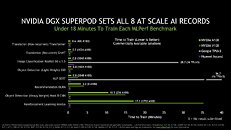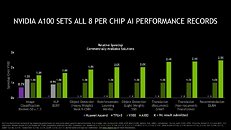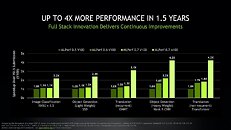- Joined
- Aug 19, 2017
- Messages
- 3,012 (1.07/day)
When NVIDIA announced its Ampere lineup of the graphics cards, the A100 GPU was there to represent the higher performance of the lineup. The GPU is optimized for heavy computing workloads as well as machine learning and AI tasks. Today, NVIDIA has submitted the MLPerf results on the A100 GPU to the MLPerf database. What is MLPerf and why it matters you might think? Well, MLPerf is a system benchmark designed to test the capability of a system for machine learning tasks and enable comparability between systems. The A100 GPU got benchmarked in the latest 0.7 version of the benchmark.
The baseline for the results was the previous generation king, V100 Volta GPU. The new A100 GPU is average 1.5 to 2.5 times faster compared to V100. So far A100 GPU system beats all offers available. It is worth pointing out that not all competing systems have been submitted, however, so far the A100 GPU is the fastest.

The performance results follow:






View at TechPowerUp Main Site
The baseline for the results was the previous generation king, V100 Volta GPU. The new A100 GPU is average 1.5 to 2.5 times faster compared to V100. So far A100 GPU system beats all offers available. It is worth pointing out that not all competing systems have been submitted, however, so far the A100 GPU is the fastest.

The performance results follow:






View at TechPowerUp Main Site




